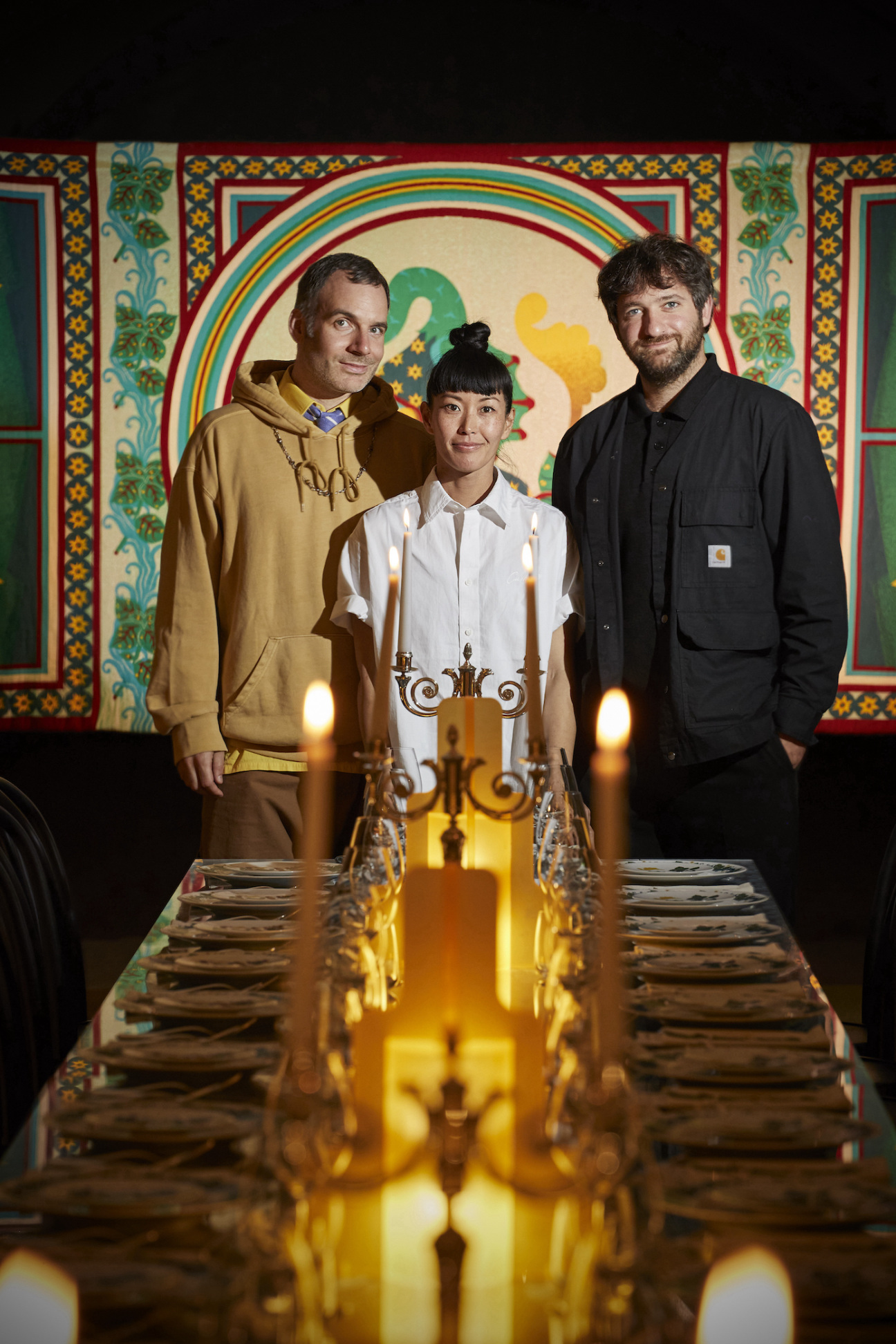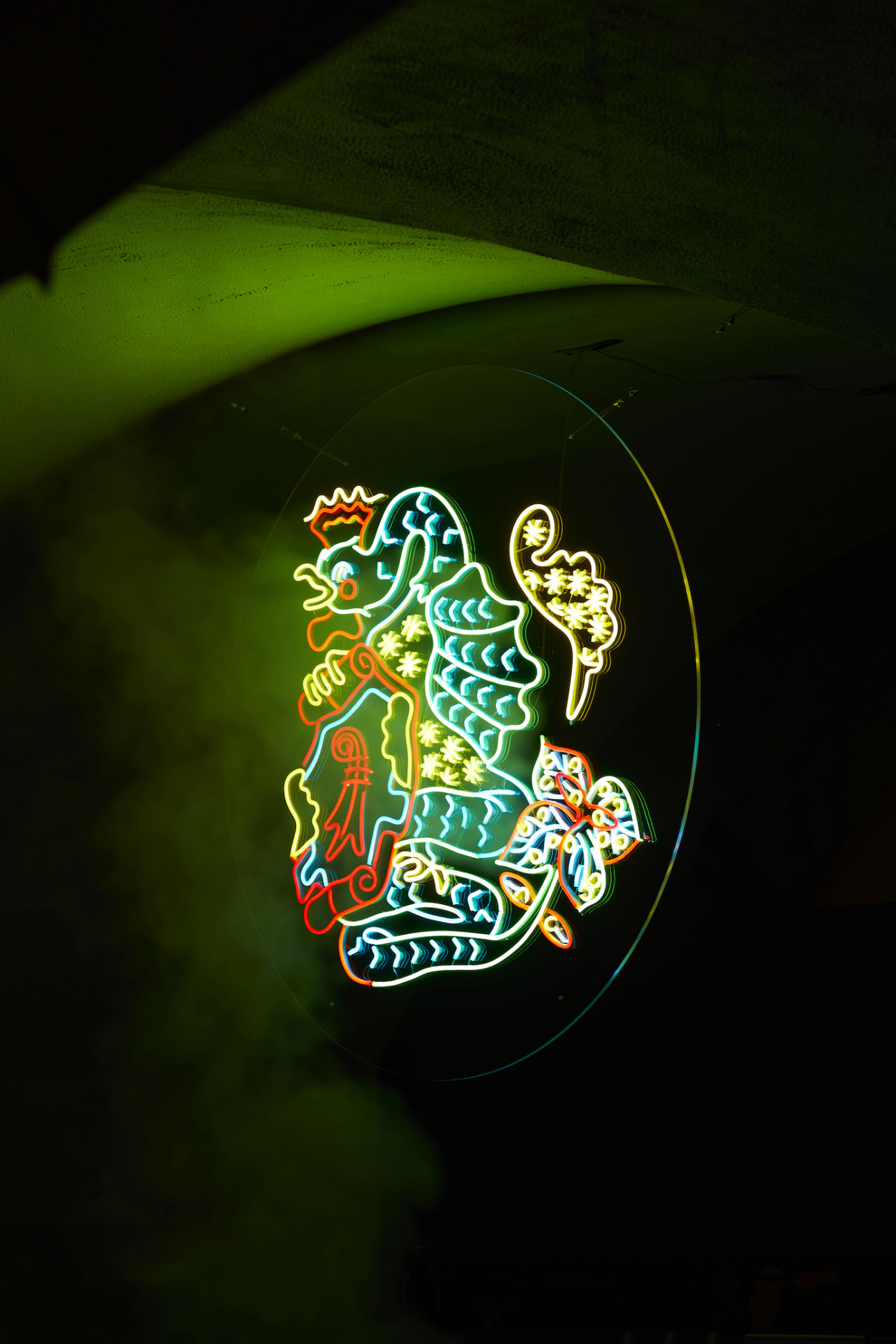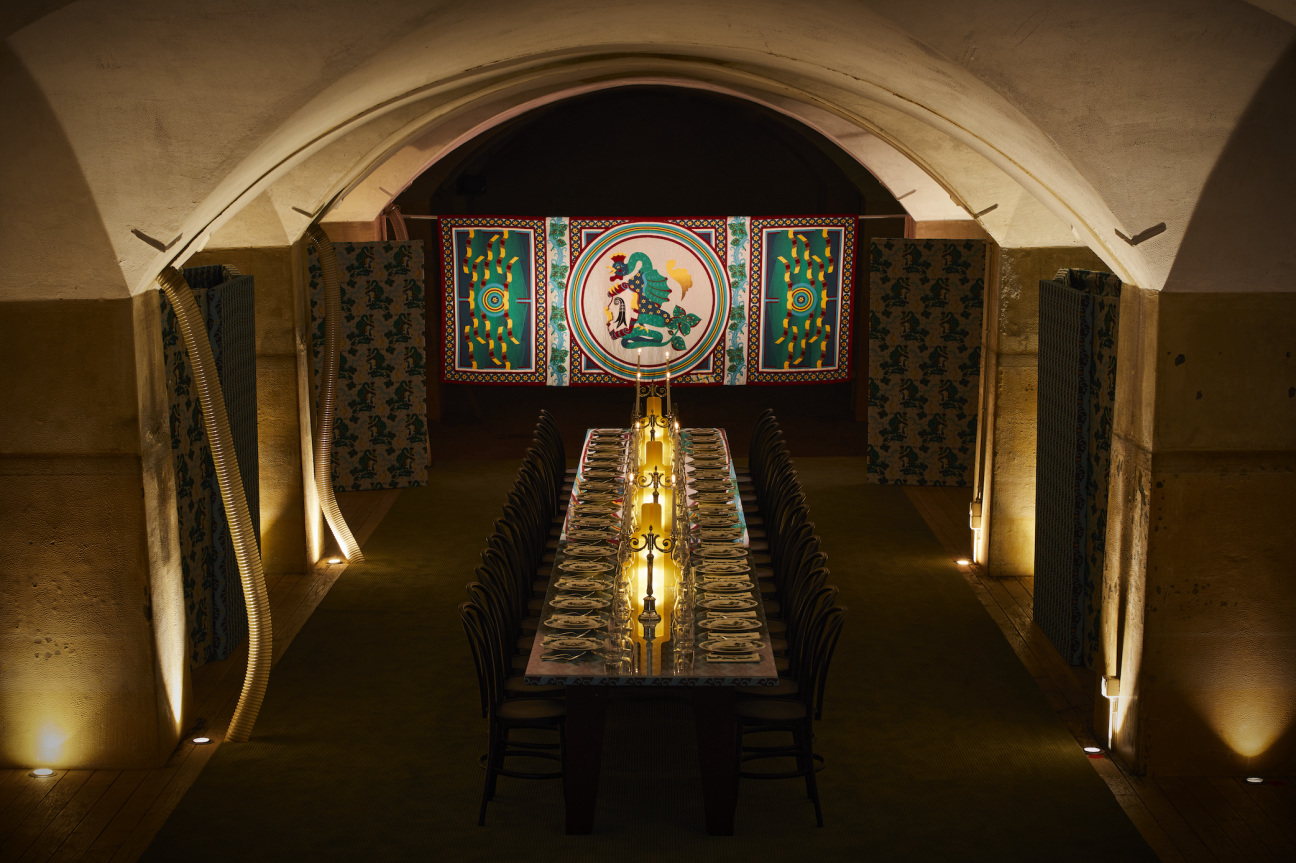
Art Basel's hottest pop-up is taking place where you least expect it.
Buzzing at the intersection of design and food, creative culinary initiative We Are Ona is bringing a one-of-a-kind experience to Basel this week, the first of its new partnership with the fair. Founder Luca Pronzato, who cut his teeth at Copenhagen's Noma, tapped designer Pierre Marie to bring their vision to life in a suprising locale: Filter4, the city's first water reservoir.
Marie’s designs utilize rich ornamentation to enhance the intended purpose of a space, and the industrial bones of the reservoir proved a delightful challenge. The dining experience features a menu from chef Sayaka Sawaguchi, whose dedicated study of culinary sustainability won her a Michelin Green star. Combining the sexy, the unexpected, and the sophisticated, the Art Basel pop-up, running through June 16, reinvents fair fare for the foodie era.
To mark the occasion, CULTURED sat down with Pronzato and Marie to talk about making the dinner table a playground, designing for conviviality, and the medieval symbol that became the pop-up's mascot.
Where are you, and what's in your system?
Pierre Marie: I’m in Paris! I had quite an intense training this morning. Right after, I was very happy to be able to have some breakfast. I had some eggs and avocado, very simple.
How do you eat your eggs?
Pierre Marie: Sunny side up, obviously. It’s more graphic. It allowed me to keep working until the beginning of the afternoon. Then I had a quick break where I mixed ricotta and apricot with a little basil. It's my favorite food for the moment.
Luca Pronzato: I'm in Paris right now. This morning was the end-of-the-year show for my son’s school. I ate some egg and made him a Nutella tartine and yogurt. At lunchtime, I had an amazing meal at a restaurant called EnYaa. It's one of the best Japanese restaurants in Paris. They do this incredible tamagoyaki to start with chicken broth, which is amazing. Then the starter was made of some fish eggs, oysters, and asparagus—it was a fancy lunch.

How did you first enter each other's lives? And how did this idea for the collaboration come about in Basel?
Pronzato: We met through a dear friend of mine, Michela Pelizzari. I come from the restaurant world: I've been a sommelier and a waiter most of my life. But I always loved the creative world. I always wanted to put food people in this creative position. I was obsessed with contemporary art and design, and Michela really introduced me to that world. One of my dreams was to do a project with Pierre Marie.
Pierre Marie: I designed Michela’s place in Milan. I think it was easy for Luca, when he discovered my work, to have a good sense of what I'm capable of because Michela’s apartment was surrounded by my work. I'm a fan of We Are Ona, and I had the chance to participate in a few dinners as a guest. It feels great to be on the other side. I love what they are creating in terms of experience and how it can go beyond food.
Obviously, we all agree that we love food, but a dinner or lunch experience is not only about food—it's about good company. Every We Are Ona dinner I went to, it was always the nicest crowd, with good surprises and some great encounters. There’s also a very special mood [there]. That was something I was eager to respect in my creation.
My work was not completely the “right” fit for We Are Ona, but there was this interesting dialogue. I wanted to bring them into my world, but also respect the identity that they created through this pop-up. Luca first asked me if I would be interested when we were in Milan together at Michela’s apartment. It was last September and I was very excited, but we only had the chance to speak about it again in January. I must say that in between September and January, I was like, “Why isn’t Luca giving me news?” When we finally spoke about it again, I was like, “I'm all for it, and I’m very happy to do it in Basel.”

You mention a specific mood that distinguishes We Are Ona from similar pop-ups. How would you describe it?
Pierre Marie: There’s an interesting contrast between a huge venue with a lot of guests and a real sense of intimacy. What they are good at is creating something that is big—very visually striking. It's very empowering, but within that big scale, you have the opportunity to have very intimate moments with the guests around you. It’s like a playground situation. In between courses, you’re able to go to another table and chat.
As a kid, I was always afraid of dinners or lunches that were super long because you'd be stuck in a chair. I always wanted to go out of the table and start playing. As an adult, I'm still like this. At We Are Ona, you can mingle and socialize in a very smooth way. It's also the casting—always the best guests.
Pronzato: It’s also the power of the politics of food. The food makes the conversation greater. The atmosphere and the design make the conversation more interesting. When you feel secure in a space, you can forget that there are people that you don't know around you and just focus on the person that you want to talk to.
In Basel, we're talking here about a water reservoir—the oldest water reservoir in the city. It's a huge space that kind of lived with and for the city. To reinvent this space gives this atmosphere where people feel it’s special and understand the love and energy that had been put into it.

How do you translate these intentions to create these “playgrounds” for a few hours? What are the specific elements that really invite this sort of behavior?
Pronzato: We're learning every day. Unfortunately, and fortunately, we don't really have models to follow. We learned along the way and made a lot of mistakes. We have this frame for having this amount of covers, this chef, this amount of dishes, the wine pairing, how we welcome the guests, how they receive an aperitivo, how we invite them to look at the space before sitting at the table, and how we take care of them, which is really different than serving them as a banquet. We don't do that. We welcome them like you would find at a restaurant. We have 20 people at 7 pm, then 20 people at 7:30 pm, and 20 people at 8, et cetera. We welcome them with the attention they deserve.
Pierre Marie: In terms of design, for me, it was very important to visit the city again. I love to do something that is very specific to a place. I was not specifically hunting for elements, but they simply jump at you when you walk around. I noticed something that I'd never noticed before: a fountain in the old city of Basel from the 15th century, which I later discovered represents a basilisk.
It was holding a crest with the heraldic symbol of the city: a black cross on white ground. The basilisk was one of the symbols of the city, mainly because of the similarity of the names Basel and basilisk. This mythological animal was often used on the fountains in the city. As Luca said, the venue was the first water reservoir of the city. I just loved the idea of taking that very strong and obvious symbol and making it the mascot of the pop-up restaurant and the guardian of the place.

The big shared tables that are a signature of We Are Ona evoked the idea of a medieval banquet for me. I thought that having a dragon be the mascot would have this heraldic and medieval feeling about it. After that, it was very easy for me because my work is all about ornaments and patterns. I have a fashion background so I'm very sensitive to textile creation. The first thing was to bring a little warmth and to make what was once an industrial place cozy. I thought, For one week, we are gonna give it a more domestic feel and give it some warmth.
I knew that textiles would be the best way to do that. I also wanted to create a neon sign that we would use for communication, as if it was an old inn. It's this game between the big scale and the small picture—the first impression you have when you enter the space and then zooming in on the experience of one guest. For the latter, we really focused on the table design and we have some exclusive plates in porcelain that were printed with my designs. I also produced some napkins made in India with block prints. I love it when the plates, the napkins, or the tablecloths [of a restaurant] are customized. For me, it's a way to tell the place’s story and to embrace its identity entirely.

What do you think the design world can learn from the food world, and vice versa, in 2024?
Pronzato: Quality [comes from] details. At We Are Ona … you have the food, the stories, the flowers, the atmosphere, and the location. Inside the location, you have the design, which is so important to create an experience. We have designed around 30 different pop-ups with We Are Ona, and they all have had a different look. This is because we think about what people see, where people eat from, where they put the table, and what the general interior design is. This is a conversation chefs and waiters should have more often. Go push the boundaries!
Pierre Marie: Well, I obviously have always been wanting to design a restaurant. This is kind of my first try, and I'm very happy with where we are with We Are Ona. It's a pop-up, but the team really pushed far beyond. I am a maximalist, and I love to do as much as possible. As a designer, I have something that I can bring to chefs or to restaurant owners, but I also have a lot of things I have to listen to because, in terms of the experience of the guests and the experience of the people working there, it has to be organic and free in terms of the flow.
This is what designers could learn about: this idea of conviviality. In Paris, there’s been a boom for many years now, where it’s either a very designed place, or it has no design at all but very good food and conviviality. Sometimes too much design can kill the vibe and the reality of the place. On the other hand, no design at all can make an experience quite uncomfortable. For me too, that’s a conversation designers, restaurant owners, managers, and chefs should have more often.










 in your life?
in your life?

